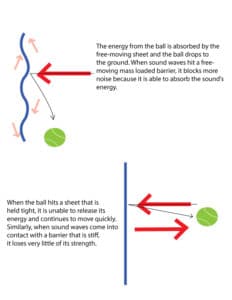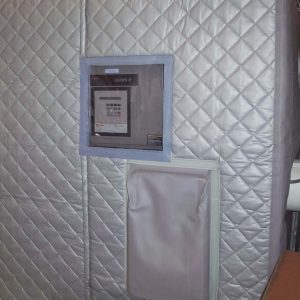Introduction
Mass Loaded Vinyl (MLV) is used almost everywhere to assist in blocking sound — walls, ceilings, doors, windows, machines, interior or exterior, and commercial or residential applications. As you will learn, MLV takes many shapes and forms to easily add mass to sound-blocking assemblies and products.
What is Mass Loaded Vinyl (MLV)?
In its base form, MLV is a thin (typically 1/8″ or 1/4″ thickness) sheet of vinyl that is infused with Calcium Carbonate (non-toxic & very dense) to add weight to such a thin product. What that means is the 1/8″ thick MLV weighs 1 lb. per square foot and the 1/4″ thickness comes in at a whopping 2 lbs. per square foot.
Why is MLV Important?
No matter the type of sound(s) one needs to block, the first two keys in sound blocking must be implemented: adding mass and total coverage. MLV takes care of both.
The mass and suppleness of MLV offer effective sound-reducing abilities, and it’s relatively easy to apply. MLV is typically attached to joists or studs covering the entirety of a new wall or ceiling assemblies before being finished with drywall. Because of its thin “thickness”, it’s a great way to add more mass to assemblies.
Also, by installing it directly to the joists/studs, it remains somewhat limp against the inside of the joists/studs. This is called “limping” or “limped mass”. Limped mass makes the assembly more effective with some larger soundwaves because it allows some “give” ensuring optimal soundproofing performance.
Think of it this way: in baseball, the foul ball net hangs loosely. This way, when a foul ball is hit into it, the net “gives” or moves with the ball, absorbing the ball’s energy. If the net were tight or rigid, the ball would bounce right back into the infield. It’s the same with sound waves and limped MLV.
Examples of MLV
Our MLV is known as AudioSeal® Mass Loaded Vinyl (MLV) Soundproofing Barrier. It has been used in a ton of applications, including the examples below of where and how it can be implemented to block noise.
Our AudioSeal® Sound Barrier is often used in sheetrock walls and ceilings in spaces like&helip;
- Residential and Commercial Buildings
- Conference Rooms and Offices
- Studios and Theaters
- Basements
- DIY-er builds like soundproof doors or boxes/enclosures
You’ll also find MLV used in combination with other products to help with specific sound issues.
For exterior use, we have our AudioSeal® Reinforced Sound Barrier that is exterior rated and is often used in building soundproof fences. Another exterior soundproofing product that uses MLV is our PrivacyShield® Outdoor Absorptive Soundproofing Blanket. These are used to block outdoor sounds like construction noise, AC units, or noisy neighbors. Check out our article, “Block Your Backyard Noise with a Noise Reduction Fence” for more information.
Many buildings, offices, and basements have suspended T-grid drop ceilings that let a ton of sound pass thru the drop ceiling and over to another space. MLV is used in products like our PrivacyShield® Ceiling Tile Barrier system and our Signature Sound Barrier Ceiling Tiles to stop the transfer of sound in T-grid drop ceilings.
In many industrial, manufacturing, or other indoor noise situations we often find that only a single noise source like the noise of a large pump on a machine needs to be blocked. For issues like this we have our PrivacyShield® Dual-Sided Absorptive Soundproofing Blanket and our interior PrivacyShield® Absorptive Soundproofing Blanket. These are typically used to make custom partial or full enclosures.
We even have AudioSeal® Clear Sound Barrier that can be used on sound blanket enclosures as a window to view important displays or monitor people that have accessed the enclosure for safety.
Check out some enclosures we’ve made at this Blanket Enclosure page.
So as you see, MLV is effective and used in many ways to block sound.
Tips and Reminders for MLV
But what if you can’t rip down your wall to put up MLV? That’s fine, no need to, really. The solution here is to find the studs behind the existing sheetrock with a stud finder, mark them with a blue line, and screw in some furring strips vertically through the sheetrock into the studs.
What is a furring strip? It is a 1″ x 3″ piece of wood, kind of like a mini 2′ x 4′. After that, install the Mass Loaded onto the furring strips, and then sheetrock over the whole thing. Easy-peasy and you have retained the maximum potential for sound blocking that the product can offer.
But make sure to caulk all the seams and gaps in the sheetrock to ensure optimal soundproofing!
Check out this Mass Loaded Vinyl Installation Video for a little help understanding installation.
Also, you can always email or call me if you’d like to talk about a specific application or place an order.
Summary
Mass Loaded Vinyl can be an effective, flexible, and affordable product for soundproofing when used correctly. On studio projects, movie theaters, and residential applications it can improve the Sound Transmission Class (STC) rating of a wall and help attenuate excess noise.
To learn more about how Acoustical Solutions can solve your noise control problems, use our contact form, call one of our Acoustical Sales Consultants at (800) 782-5742, or visit us on the web at acousticalsolutions.com.

